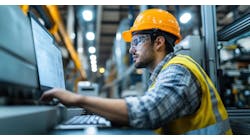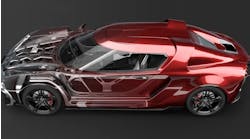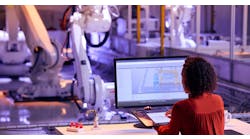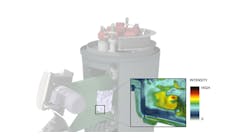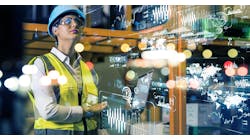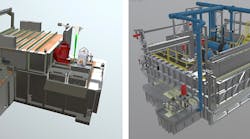Most people have experienced or at least heard of virtual reality for gaming, but still are surprised at how the technology has caught on in manufacturing applications. Some tech industry analysts project that the combined augmented reality (AR) and virtual reality (VR) market will register growth in the billions of dollars for equipment demonstration, inspection, training (especially safety), process manufacturing and maintenance. AR/VR technologies are helping manufacturers to increase their digital transformation efforts to achieve Industry 4.0 capability, and they are emerging as the major change agent for many manufacturing sectors. Metalcasters surely will be included.
The hardware and development time necessary to adopt these technologies has decreased significantly over the past few years, making VR very affordable options for any manufacturer. The manufacturing benefits of using VR include:
– Demonstrating equipment, to explain heavy, bulky and dangerous equipment safely.
– Designing production floors, to ensure the design is correct for your plant, operators, and processes.
– Simulating production processes, to verify cycle times and production rates.
– Inspecting equipment designs, to verify custom equipment before steel is fabricated and controls are programmed.
– Safety, operational, and maintenance training, to safely train operators how to clean, operate and maintain dangerous equipment.
– Attracting talent.
1. Demonstrating equipment. We can demonstrate so much more in VR than we ever could with 2D or 3D drawings. With VR, customers can easily inspect and manipulate a 3D image to show all sides and underneath the unit, to see how it works from the inside. That cannot be done with videos, photographs, or drawings.
Additionally, we have added VR models to our website for potential customers to view them—all over the world. We showed our furnace VR to the major electric car manufacturer and ended up getting a contract to build several new furnaces there. When your customers realize you are on the cutting edge of technology, they are eager to work with you. We credit much of our increase in sales because of this capability.
At tradeshows, instead of shipping heavy equipment (at major expense) I just bring VR equipment. For a fraction of the shipping cost I am able to show customers just about any furnace type we build. We no longer need to arrive at the event two days early to set up the booth. The cost of everything more than paid for itself the very first show!
We have completed a total of six shows with our VR system and saved over $72,000 in three years. Better demonstrations at less cost… meaning it is truly cost-effective.
2. Designing production floors. Think about having the ability to show potential customers their plant layout in VR. It looks clean, well-managed, and operators can review it for accuracy and functionality, meaning how material will move through the production floor. Seeing their improved operating in VR can reveal potential problems that may not be noticed in a traditional drawing. Identifying potential problems before floors are poured and metal is fabricated can save a foundry thousands of dollars, or even tens of thousands.
A building or factory layout can be assembled rapidly and modified during a collaborative session and displayed on-screen for multiple participants, either local or networked. Users can position machinery or components inside a virtual copy of the foundry environment using ‘hand tracking,’ which allows users to ‘grab’ virtual objects and position them directly.
Once a layout has been assembled, users can tour and experience the design and determine if more changes are needed.
Using VR is ideal for planning to add a robotic cell or other automation equipment to an existing layout, as operators can position machinery within a virtual copy of the foundry to ensure proper workflow. With immersive VR you can readily review any building obstacles.
3. Simulating processes. VR provides the ability to see your equipment in action, in your customer’s environment to demonstrate cycle times and verify productivity. Unlike a video, virtual reality is a medium that can demonstrate a process in the specific location where it will be installed – an invaluable perspective for foundry plant managers.
4. Inspecting equipment designs. Foundry equipment is custom equipment by definition. It must meet productivity demands as well as floorspace requirements. With VR, you can inspect a 3D drawing to verify it’s correct for your operation. Verifying it in VR, also allows for easy changes to the CAD, versus expensive changes to the equipment later.
5. Safety, operational, and maintenance training. Imagine placing an 18-year-old trainee in front of an 1,800 °F furnace opening, instructing him to “clean that.” It’s likely that employee will go to lunch and never come back! However, put a VR headset on an employee to teach him how to clean a furnace properly (with interactive responses) and you will have prepared him to handle one of the hottest and toughest jobs in the plant – safely.
This type of training can be developed and implemented to almost any job in your plant. Using VR, you can train workers for virtually any part of your manufacturing process, to impart principles and practices for safety, operation, troubleshooting, and maintenance. All you need is a laptop and headset, and you can offer your operators training on-demand, as you and they require it.
The benefits of VR training with cannot be exaggerated. With the aid of VR, individuals retain more information -- especially critical for dangerous environments -- as workers learn faster, retain better, and are able to experience the actual hazards of a particular process without the risk of getting hurt. In VR, they can learn to drive a forklift or operate machinery and understand hazards. Furthermore, you can add testing to the training to ensure the objectives of the course are understood.
Take your basic safety training video (most are boring, and fewer are even watched) and replace it interactive VR. Then, watch what happens.
6. Attracting talent. In addition to all of the above technical and money-saving advantages, we also have recognized an important, manufacturing-specific benefit: enticing young people to want to join the workforce. We have attracted several new engineers primarily because we demonstrated our furnace products to them using virtual reality.
Engineers coming out of universities today have been exposed to these technologies; therefore, when you present them with proof that you are actively using these technologies you confirm for them that you are the right organization for them to start their professional careers. In an industry that struggles to attract new talent, we suggest VR will help to make your products and proposals more promising.
Furnaces are large, heavy, and complex equipment. The Schaefer Group uses VR regularly to demonstrate equipment to tradeshow visitors and customers at their locations. We have used VR to help foreign customers to inspect and approve their custom equipment. And, we continue to add more training modules to meet our customers’ safety and operational training needs.
You too can demonstrate equipment, layout a production floor, verify processes, and train more effectively for less money with the use of VR. There’s nothing preventing you from experiencing the many productivity benefits of using virtual reality in your manufacturing operation.
David W. White is the former national sales manager for The Schaefer Group Inc., as well as a personnel trainer and speaker on metalcasting technologies. Contact him at [email protected]


